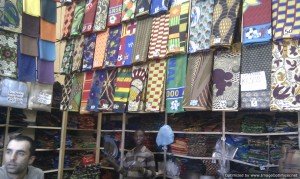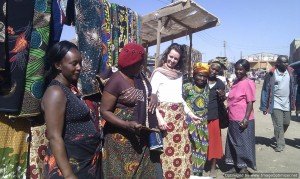You buy me in either two metre lengths, or six metre pieces. I can be flimsly, see-through, thick, even waxy.
Sometimes I’m made of synthetic polyester, and sometimes of cotton.
I come in many different colours, with a multitude of designs printed on me, often with significant meanings.
I can be used in many ways, from a wrap-around dress or skirt to a table clothe, from a headscarf to a baby sling to carry young children, and also as wall hangings. I’ve even been known to be given as gifts to Chiefs.
I’m mostly used in Africa, and am the traditional dress for women in Zambia. This is because women preserve their modesty by using me to cover the more sensual parts of their bodies, from their waist down, and even over trousers.
I’m also very practical, in that I help keep the clothes under me clean from the dust and charcoal fires, and can act as padding when carrying water on your head.
What am I?
I found out the answer, being a Chitenge, yesterday, as Jane and I  walked the dirty streets of the market in Lusaka. We found many street vendors selling chitenges, and most shops had a few on offer. Some stores even specialise in just these sarong like clothes.
walked the dirty streets of the market in Lusaka. We found many street vendors selling chitenges, and most shops had a few on offer. Some stores even specialise in just these sarong like clothes.
We’ve bought some as gifts for the Chiefs to follow protocol, and will be also giving them bags of maize and rice and bottles of oil. Having not packed any skirts myself,  I picked up a few as it is required that women wear them when meeting a chief.
I picked up a few as it is required that women wear them when meeting a chief.
Not that I minded shopping and getting a few. The designs and colours are so lovely, I had a hard time choosing which ones to get! The street vendors, and even some women passing by, stopped to help me choose though, and have a bit of a dance to the music blasting from the local CD shop, a few stores down the street.

So, do I look ready to explore the rural areas and meet some Chiefs and their communities?
Written by Telana Simpson
